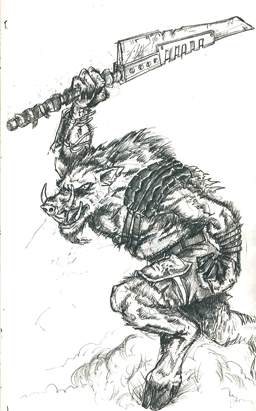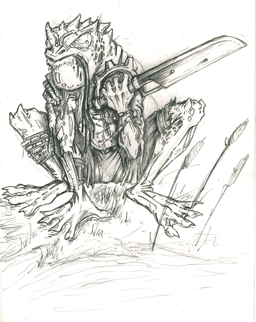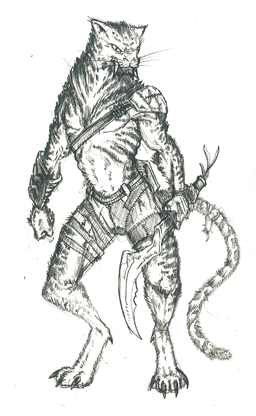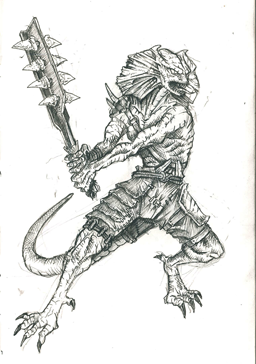Manimals
Contents
RP Notes From Estate Management
"Anthro fans, furries, manimals as we call you, this is a humanoid setting (mutants and ghouls count). However you are ok to RP here with the caveat that you are in our world. This world does not contain cute cartoon animals frolicking through the blistering radiation and quicksand deathtraps, it simply makes no sense. Aesthetically or logically. If you want to be an anthro here we ask that you at least attempt to be an anthro that is appropriate to the setting. Ultimately remember, we don't HAVE to let anthro roleplay go on here, we choose to and we have given you an interesting and different way of approaching your roleplay fandom. Enjoy it, try something new. Either that or take the old avatar off and join the other humanoids if you want to play here."
MANIMAL A humanoid/animal hybrid of nearly unidentifiable species (some distinctive breeds have been noted) and unknown origins. Covered in matted fur, cracked scales, or a scarred filthy hide. Suffering from mange or outright diseased. Darting eyes, suspicious and hungry, barely discernible from the other mutated monsters in the wilds except for a brief glimmer of intelligence, something different ... something that would almost be endearing if they weren't clearly sizing you up for dinner.
Physiology (General)
Manimals are animals that through genetic accident or experimentation became humanoid in some fashion. A growing variety of species were observed or rumored upon their appearance in the Age of Destruction. Among the warring nations, a common theory postulated that manimals were the result of a manufactured and/or mutated viral plague infecting a variety of animal hosts. These animal hosts then passed it on to offspring creating another "manimal". Despite the rumors, accurate knowledge of their true origin was lost long ago in the ash and dust of the Age of Destruction. Since then, their modified genetics have survived and carried on through various generations.
Most manimals tend to have heightened senses, and pack hunting habits. Manimals communicate with one another through body language, sounds (roars, growls, squeaks, screeches), and scents (most of which cannot be detected by the other races). Human and mutant language, speech patterns and pronunciation are difficult due to their animal physiology. The varying shapes of their muzzles, throats, fangs, and mouths impact the pronunciation of most words. Manimals can pick up certain words and mimic manners of speech after listening and watching the other aces. Most manimals articulate words, phrases, and concepts in combination with animal sounds, scents, and pantomimed gestures in order to communicate.
History
Manimals are too diverse and spread out, and thus have no unifying overall history. Individual tribes, classes, packs, or families may have folktales and stories centered upon mythic ancestors of their particular manimal type.
Social Culture (General)
To date no records of any large manimal cultures exist in the world after The Fall, though in the rare instance that two of these creatures encounter each other, they sometimes form some form of bond in their pariah status. Although exceptional examples can be found living amongst humanoids, manimals must tread carefully around humanoid society lest they fall victim to the inevitable suspicion and trials that will follow them.
Manimals from various breeds have been known to band together into packs or tribes with an appointed chieftan/leader and sometimes with an additional "spiritual" leader. Customs and beliefs may be defined by significant animal totems representative of their animal ancestors but also certain old world objects, such as the salvage and healing masheen, may acquire mystical significance.
Regardless of specific racial differences, all Wastelanders typically live and react to circumstances in one of three basic manners: as a Hunter, Harvester, or Scavenger. Individuals lean more towards one or another or let their attitude toward a situation shift freely to suit their survival. Manimals, on the other hand, are driven primarily by animal instinct corresponding to only one of those three manners:
- The Hunter is always stalking prey or defending its territory. Hunters may be aggressive and savage, or calculating and cunning. Hunters are always hungry and observing potential prey and competition.
- The Harvester is always gathering and hoarding supplies to survive. Harvesters avoid conflict when possible relying on stealth, caution, or retreat but they are not harmless. Harvesters WILL fight when cornered. Some with deadly effect.
- The Scavenger exists between the two, watching from afar. Like Harvesters, they constantly gather and hoard supplies. In conflict or danger, they may be crafty, evasive or eager to fight for their scraps and territory.
Despite being defined by only one of the three basic instincts, manimals are a tremendously diverse race in the Wastelands with much personality. Some are naturally curious and possibly docile. Others are quick to bite with little to no warning. In a tense or threatening situation, they will always react by their basic instinct.
Modern Day and Manimal Classes
Many humans and Mutants consider manimals to be little more than an animal on two legs. While many Manimals seem to develop more complex neural capacities including language and rudimentary communication, it does little to help their acceptance with the other humanoid races. They are often seen simply as being too alien from human and humanoid culture to be kin. In turn, many more intelligent manimals consider themselves too different than to accept humans and humanoids. Relationships between manimals and humanoids are strained at best. Their status as "almost-animals" makes humanoids suspicious and wary of their presence.
MANIMAL CLASSES
Over time and based upon observation, stories, rumor, and legends, manimal diversity in the Wastelands has been documented into particular "Classes". Where necessary, certain classes have been divided further into families and breeds. These classes and their subdivisions possess additionally distinctive physiologies, behaviors, and social cultures.



